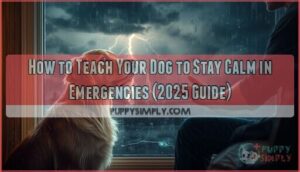This site is supported by our readers. We may earn a commission, at no cost to you, if you purchase through links.

Your dog hears the smoke alarm’s piercing shriek and bolts under the bed while you’re trying to evacuate. Or thunder cracks overhead during your evening walk, and suddenly you’re wrestling 60 pounds of panicked fur trying to drag you home. These moments reveal a hard truth: the skills your dog has mastered in calm conditions can vanish when stress floods their system.
Research shows that 53% of noise-sensitive dogs fear multiple triggers, and that anxiety compounds each year—meaning the trembling pup you have today could become far harder to manage during a real crisis.
Teaching your dog to stay calm in emergencies isn’t about being completely without fault under pressure. It’s about building a foundation of trust and practiced responses that hold steady when instinct screams at them to run, hide, or freeze.
Table Of Contents
- Key Takeaways
- Recognizing Emergency Triggers for Dogs
- Essential Commands for Emergency Calmness
- Building Calmness Through Desensitization
- Creating Safe Spaces and Emergency Plans
- Strengthening Emotional Resilience in Dogs
- Frequently Asked Questions (FAQs)
- How to train your dog for emergencies?
- How to keep a dog quiet in an emergency?
- How do you teach a dog an emergency stop?
- How do I prepare my dog for an emergency?
- How do I handle my dogs panic during a natural disaster?
- Are there specific breeds that are more prone to anxiety?
- Can I use positive reinforcement for emergency training sessions?
- How often should I practice emergency training with my dog?
- Can medication help anxious dogs during emergencies?
- How do service dogs stay calm professionally?
- Conclusion
Key Takeaways
- Emergency calmness isn’t instinctive—it requires building foundational skills through consistent training of core commands like “stay,” “come,” and “settle” before crisis situations arise.
- Desensitization works by gradually exposing dogs to triggering sounds (alarms, sirens, thunder) at low volumes while pairing them with positive experiences, with studies showing over 70% success in reducing noise phobias.
- Your stress directly transfers to your dog through synchronized cortisol levels, making your own emotional regulation during emergencies as critical as your dog’s training.
- Monthly evacuation drills, designated safe zones stocked with supplies, and an updated emergency kit are essential preparation steps, since nearly 50% of pet owners have left animals behind during real disasters.
Recognizing Emergency Triggers for Dogs
Before you can train your dog to stay calm, you need to know what sets them off in the first place. Every dog reacts differently to stress, and recognizing their specific triggers is the foundation of effective emergency preparation.
Let’s look at the most common situations and signals that cause dogs to panic so you can address them head-on.
Identifying Common Emergency Situations
Emergency scenarios come in all shapes and sizes, and recognizing threats quickly makes all the difference. Understanding these scenarios helps you develop targeted calming techniques and emergency preparedness strategies for effective anxiety reduction. Knowing the signs of dog medical emergencies can help you react quickly.
You’ll want to prepare your dog for these common situations:
- Fire emergencies requiring immediate evacuation
- Natural disasters like earthquakes or floods
- Medical crises where you need assistance
- Noise-related panic from fireworks or thunderstorms
- Traffic accidents or hit-by-car incidents
Recognizing Physical and Emotional Stress Cues
Once you spot the situation, watch for your dog’s stress signals. Physical indicators like barking (29% of stress reactions), panting, pacing, and trembling tell you something’s wrong. Emotional signals—yawning, lip licking, or retreating—matter just as much.
Stress clustering happens when multiple cues appear together: whale eye, ears back, and excessive salivation. Unfortunately, 88% of owners miss yawning as a sign of anxiety. Recognizing these signs helps you spot stress signals early.
Learning these physiological responses strengthens your dog behavior training and builds emotional resilience through better stress reduction.
Understanding Breed and Individual Sensitivities
Your dog’s breed predispositions and genetic factors matter. Female dogs show 1.3 times higher noise fear than males, while neutered dogs demonstrate 1.7 times greater sensitivity. Age influence is real—fear increases 3.4% yearly.
Lagotto Romagnolos and Wheaten Terriers exhibit higher anxiety than Boxers. Comorbidity patterns mean 53% of noise-sensitive dogs fear multiple triggers, requiring specific anxiety management for emotional resilience and behavioral flexibility.
Environmental Factors That Cause Canine Anxiety
Urban living amplifies anxiety—city dogs show higher fearfulness than rural counterparts, while inactivity worsens stress responses. Early experiences shape lifelong coping: puppies missing proper socialization face 26-44% fearfulness rates. Exercise deficits compound noise sensitivity problems.
You’ll notice that dogs with minimal exposure to novel environments struggle in new settings. That’s why building stress management skills and safe spaces through varied experiences becomes critical for anxiety management.
Essential Commands for Emergency Calmness
When panic strikes, your dog’s response depends on the foundation you’ve built beforehand. A handful of well-trained commands can mean the difference between chaos and control when seconds matter.
Let’s look at the core skills every dog needs to navigate emergencies with confidence.
Teaching Reliable “Stay” and “Come”
When seconds count, you need basic commands your dog obeys instantly—no second guessing. Start recall exercises with positive reinforcement in low-distraction environments, rewarding every successful “come.”
Gradually increase stay duration from seconds to minutes, practicing command consistency daily. Dogs trained weekly achieve higher success rates than daily drilling.
Layer in distraction training slowly, building recall reliability that transforms dog training skills into life-saving emergency responses.
Training The “Settle” or “Place” Command
When chaos strikes, teaching “settle” or “place” gives your dog a portable safe space and calm demeanor. This cue trains your dog to remain quiet on a mat or bed, reducing stress in emergency situations far more effectively than rigid immobility.
- Begin 5-minute sessions at home, rewarding any interaction with the mat
- Build duration from 2 seconds to 10, spacing treats to avoid frustration
- Place food between front paws to encourage a low, relaxed head position
- Practice around household noise—sweeping, footsteps—to strengthen generalization
- Add the verbal cue only after your dog reliably chooses the spot and settles
Mastering Emergency Stop Techniques
Freezing on command can pull your dog back from traffic, downed wires, or other emergency scenarios where instant inhibitory control saves lives. Start training progression with “halt” on leash, rewarding every stop at 3 feet, then 10, then 30.
Whistle commands offer signal differentiation when distance grows—train distinct patterns for stop versus recall. Track performance metrics to confirm reliability before testing off-leash in controlled settings.
Using Positive Reinforcement Consistently
Reward timing separates effective positive reinforcement training from guesswork—mark the exact moment your dog complies, then deliver treats within one second.
Consistent cues prevent confusion during high-stress scenarios, so use identical words and hand signals every repetition.
Reducing aversives keeps your dog focused rather than fearful, building the generalization skills needed when emergencies shift locations.
Handler consistency determines whether training dogs for emergencies succeeds or unravels under pressure.
Building Calmness Through Desensitization
Desensitization works by gradually exposing your dog to the sights and sounds that trigger fear, building tolerance one small step at a time. When done correctly, your dog learns that alarms, sirens, and chaotic situations aren’t threats—they’re just part of life.
Here’s how to approach each key aspect of desensitization training.
Gradual Exposure to Alarms and Sirens
Dogs can learn to tolerate warning alarms through careful sound frequency adjustment and volume increments. Start early exposure with recorded smoke alarm sounds at barely audible levels during mealtime or play—this positive association forms the foundation of desensitization tools.
Follow this three-step protocol:
- Play recordings 10 seconds daily at whisper volume
- Increase intensity by small steps every three sessions
- Pair each session with treats for anxiety relief
Your dog training patience prevents emergency panic.
Practicing Evacuation Drills With Your Dog
You wouldn’t expect a fire drill at 2 a.m., but neither will your dog. Regular evacuation drills—ideally monthly—turn chaos into routine. Practice loading carriers, clipping leashes, and moving through your planned exit route together.
This drill frequency builds muscle memory for both of you. Since nearly 50% of pet owners left animals behind during real evacuations, consistent carrier training and separation prevention through rehearsed dog procedures directly improve your emergency response training and overall dog safety in emergencies.
Counterconditioning to Reduce Noise Phobias
After you’ve practiced evacuation movements, it’s time to tackle the sounds themselves. Counterconditioning pairs scary noises—sirens, alarms, thunder—with something your dog loves, like high-value treats. Start recordings barely audible, rewarding calm behavior.
Studies show 70.8% success in reducing stress in emergency situations through this positive reinforcement training. Gradual volume increases build desensitization efficacy.
For severe cases, combine treat pairing with thunder shirts or soothing music as prevention strategies for long-term management of noise sensitivity.
Maintaining Calm During Practice Scenarios
Once you’ve paired treats with scary sounds, your practice sessions need structure. Keep training under 15 minutes—longer drills trigger stress. Start in your dog’s favorite room, reward timing immediately after calm behavior, and stay relaxed yourself; dogs mirror handler calmness.
Mix drill variety: alternate loud and quiet noises, practice settle in the crate, add distraction training. Positive reinforcement training works only when you control noise and session length carefully.
Creating Safe Spaces and Emergency Plans
A well-prepared home gives your dog something to lean on when chaos strikes. Whether it’s a smoke alarm or a sudden evacuation, knowing where to go and what to bring makes all the difference.
Let’s walk through the essentials—starting with the spaces that help your dog feel secure.
Setting Up Designated Safe Zones at Home
In your home, choose an interior room away from windows—like a bathroom or utility room—where flying debris and loud sounds won’t reach your dog. Clear the space of hazards, secure doors to prevent escape, and stock it with water, food, and medications.
This safe zone becomes your dog’s shelter during storms or crises, and co-sheltering there keeps both of you calmer and safer together.
Introducing Crates and Familiar Items
Building positive associations with crates starts with scent association and item selection. Toss treats inside, let your dog explore freely, and never force entry. Place familiar bedding and a favorite toy inside to trigger oxytocin release, lowering stress by half.
Within two weeks of daily practice, most dogs settle willingly. A well-introduced dog crate becomes secure transport during evacuations and a portable safe space anywhere.
Packing and Maintaining an Emergency Kit
Before disaster strikes, assemble your go bag with a two-week food supply in waterproof containers, plus medical records, medications, and your dog’s microchip number. Include a pet first aid kit with gauze, antiseptic wipes, and styptic powder.
Review kit maintenance every six months—replace expired medications, refresh water, and update documentation after vet visits. Only 40% of owners maintain actual preparedness stats like these.
Developing a Family Emergency Evacuation Plan
Map two evacuation routes from your neighborhood before an emergency strikes—blocked roads are common during disasters. Designate pet-friendly destinations outside the risk zone: hotels, boarding kennels, or relatives who can shelter your dog.
List emergency contacts, decide who cares for each dog, and practice transport methods with crates near exits.
Update your plan annually, especially after household changes, so everyone knows their role when it’s time to evacuate.
Strengthening Emotional Resilience in Dogs
Emotional resilience isn’t something your dog either has or doesn’t have—it’s a skill you can build together over time. The stronger your bond and the more consistent your training, the better your dog will handle unexpected situations when they arise.
Here are four key areas to focus on as you strengthen your dog’s ability to stay calm under pressure.
Building Trust and Owner-Dog Bond
Your dog’s trust isn’t built overnight—it’s earned through every interaction. Positive reinforcement training methods strengthen your bond, making your dog more responsive during emergency situations.
Consistent communication and shared activities create emotional security, while mutual respect forms the foundation. Dogs with strong owner bonds show 50% better retention in behavior training, meaning your investment in connection directly improves emergency preparedness.
Managing Your Own Stress During Emergencies
Your stress radiates straight to your dog—cortisol levels synchronize between you and your pet, amplifying anxiety in crisis moments.
Your stress syncs with your dog’s cortisol levels, amplifying their anxiety during emergencies
Breathing techniques and emotional regulation are your most powerful tools. Practice counted breaths (4-4-4 rhythm) before emergencies hit, building mental preparedness that keeps both you and your dog grounded.
Staying calm isn’t just good advice—it’s a biological necessity for managing dog stress effectively.
Reinforcing Calm Behaviors in New Environments
New places can scramble even the best-trained dog’s responses—that’s where environmental generalization bridges the gap between home practice and real-world reliability.
- Reinforce calm behaviors with consistent cues across multiple locations, gradually increasing novelty
- Time your rewards within seconds of desired responses to strengthen connections
- Watch stress thresholds closely; 90% of dogs respond successfully when you keep training below their anxiety trigger points
Emotional resilience grows when you practice staying calm everywhere, not just at home.
Tracking Progress and Refreshing Training Regularly
Think of training like building muscle—regular check-ins keep skills sharp when seconds count. Logging Benefits from structured tracking reveal Progress Metrics that predict emergency readiness, while Retention Studies confirm weekly sessions beat daily marathons for long-term recall. Assessment Tools like success-rate tracking expose gaps before crisis strikes.
Refresh your dog’s Training Frequency every few weeks; even star performers need tune-ups to maintain reliable dog behavior in new environments under pressure.
Frequently Asked Questions (FAQs)
How to train your dog for emergencies?
You’d never skip a fire drill at work, yet most owners overlook preparing dogs for emergencies.
Train your dog using desensitization methods, command reliability, settle skills, safe zone training, emergency kit preparation, and resilience building exercises.
How to keep a dog quiet in an emergency?
Teaching the “settle” command, using anxiety wraps, calming chews, and distraction techniques can quiet dogs during emergencies.
Practice crate training and muzzle training beforehand.
In severe cases, discuss veterinary intervention options to support pet safety during evacuations.
How do you teach a dog an emergency stop?
Start with your dog just steps away. Say a unique verbal cue, reward any immediate settle or freeze, then gradually build distance.
Practice once daily using high-value treats to maintain emergency reliability and welfare considerations throughout training.
How do I prepare my dog for an emergency?
The best emergency preparedness for pets begins when nothing’s wrong.
Start with an emergency kit containing food, water, medications, and veterinary records. Microchip your dog, arrange an evacuation buddy, and learn basic first-aid training.
How do I handle my dogs panic during a natural disaster?
Recognize panic signs like panting or pacing. Move your dog to a safe transport carrier, speak calmly, and minimize chaos.
After the natural disaster, maintain routines and monitor for prolonged stress needing veterinary support.
Are there specific breeds that are more prone to anxiety?
Yes—genetics shape temperament. Lagotto Romagnolos, Wheaten Terriers, Spanish Water Dogs, and Shetland Sheepdogs display higher anxiety heritability.
Breed predispositions matter, but individual temperament traits and comorbidity risks also influence a dog’s emotional resilience during crises.
Can I use positive reinforcement for emergency training sessions?
Absolutely. Positive reinforcement works brilliantly for emergency training—reward-based methods reduce stress and build long-term retention.
Train your dog using treats to reward calm behavior, creating welfare benefits without aversive alternatives while preparing pets for disasters.
How often should I practice emergency training with my dog?
Training frequency matters. Aim for 2-3 short sessions weekly, 10-15 minutes each, to build reliable emergency behaviors.
Drill consistency prevents skill regression, so practice evacuation scenarios regularly while monitoring your dog’s stress signals.
Can medication help anxious dogs during emergencies?
Medication can reduce fear and stress during crises. Emergency anxiolytics like trazodone or gabapentin offer short-term relief, while long-term antidepressants address chronic anxiety.
Always combine medication with training for multimodal management and consult your vet for safety.
How do service dogs stay calm professionally?
Service dogs aren’t born calm—they’re the cream of the crop. Selection criteria screen out anxious candidates, while task training and public access standards demand perfect stress regulation. Welfare protocols guarantee sustainable canine assistance performance.
Conclusion
When the smoke alarm wails at 2 a.m., your dog’s response becomes the difference between smooth evacuation and dangerous chaos. How to teach your dog to stay calm in emergencies isn’t a weekend project—it’s an ongoing commitment to practice, patience, and consistency.
Start with one command today. Run one drill this week. Because the moment crisis strikes, your dog won’t rise to the occasion. They’ll default to their training.
- https://pmc.ncbi.nlm.nih.gov/articles/PMC7058607/
- https://www.sciencedirect.com/science/article/abs/pii/S016815911200367X
- https://greenelementcbd.com/pages/pet-anxiety-2022
- https://www.reddit.com/r/dogs/comments/37umem/fluff_i_took_a_bit_of_a_deeper_dive_into_the/
- https://www.countryliving.com/uk/wildlife/pets/a43682561/pet-first-aid-warning-pdsa/













